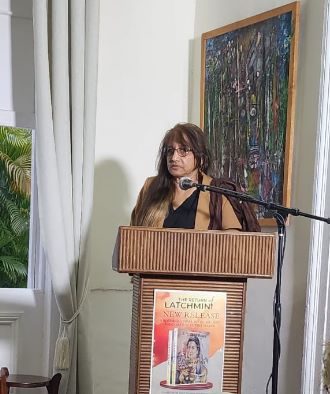Dr. Seeta Shah Roath, lecturer at UG and a media specialist, launched her novel “The Return of Latchmini” (2022 publication) in person in Guyana in late March and internationally via zoom in early March. It is ‘a heartfelt’ (emotional) novel but is related to an episode in Indian history; it contains factual information of real events that occurred during Indian indentureship albeit about Dr. Seeta’s maternal great-grandmother Latchmini and her spouse (great grandfather), and their three children. It is an evocative story that is rigorously researched, drawing upon collective memory of family members. It expands our knowledge of indentureship and what it means to be an indentured laborer.
The ‘Return of Latchmini’ is a touching novel that will surely engross readers. It brings to vivid life this extraordinary story of indentureship that exposes just one evil of the labor system (separating members of a family) that was never before told — a tale of hardship and horror. It powerfully examines the horrors of indentureship, an emotional novel, a significant contribution to literature on Indian indentureship. It is a compelling read, told with honesty and authenticity. It is masterfully related , a moving story that makes readers feel pain, terror, and anguish about that horrible system of involuntary labor.
Much of history is penned as novel. When I did PhD studies in history decades ago, ‘the novel as history’ was a course offered by Distinguished Professor Arthur Schlesinger Sr (Advisor to JFK who toppled the Cheddi Jagan government) who prescribed several novels as mandated reading with presentations in class including a couple novels from V.S Naipaul’s several prize award works. I would include Dr. Seeta’s novel in the category of ‘novel as history’ that should be prescribed in courses in history, Indian Studies, Indentureship or Involuntary Labor Studies, and Literature. It is a very interesting story that every literate person interested in the indentureship experience should read. This is Seeta’s first novel, but she has complete control of her story and the style of writing is makes it easily readable. It is so well narrated that one feels as though he or she is an eyewitness to the events; everything is told emotionally with clarity. The writer not only tells about an important event of history but also about how humans can be unkind to fellow humans exploiting and separating loved ones from one another over acquisition of money.

Parts of the experiences of indentureship have been told by several writers long before Dr Seeta but not with the kind of freshness, revelations, suffering, intensity and power as presented by Dr. Roath. Indentureship has not been in the news lately. With this novel, the subject is propelled back to media attention. I envy Seeta’s ability to bring to life a long forgotten subject. The experience of the indentureds should never be forgotten.
The novel tells a real story. It is an extremely powerful story of a young family (Latchmini and her husband and their eldest son) being broken up or destroyed to serve the interests of greedy arkatiyas (recruiters/deceivers of indentured laborers or girmityas), planters, and colonial interests. It makes references to Latchmini’s family in India, Surinam, back to India where she returned after completing her Suriname indentureship girmit (contract), and thence in British Guiana.
The plot centers around a family who was denied their dignity, unity, and nuclear relationship as they sought to improved their lives as a unit. Latchmini and her two youngest children got separated from the husband and another son left behind in Surinam where the family was indentured. The family got separated because of their innocence of the exploits of indentureship that was only about generation of wealth for planters and showed no empathy or emotion for the suffering or the harm of families (husband and wife with children) being separated. The Latchmini family was very patriotic about homeland and wanted to return to the land of their birth. After completing their indentureship in Surinam and acquiring some savings, a pregnant Latchmini was sent back to India (with a small child to India) to make preparations for the permanent settlement; husband and eldest son would join them in their native (village) homeland. Latchmini ran into conflict with her in-laws who did not welcome her, querying why the husband also didn’t return (with her). Latchmini had to care for herself and a child. She could no longer bear the insult and abuse as her saved funds were being depleted with no support from in-laws. She decided to return to Surinam with her son as girmityas. She enlisted to return to Surinam, answering the call of the arkatiya (recruiter). She trusted the arkatiya and the European employers that they would safely return to Surinam. She risked her life and that of a child to get back to her husband and other son left behind there. Latchmini was deceived by the arkatiya that they were returning to her husband and son in Surinam. Instead, they were taken to Guiana. Latchmini gave birth at sea just before landing in British Guiana instead of Suriname as she soon discovered. Latchmini was fooled, misled, and deceived. The family would forever be separated from husband and son left behind in Surinam.
Latchmini found herself and her two youngest children separated from the other two family members in Surinam. The woman never saw her husband and son again, and they of her and other two siblings. One can imagine the grief in the heartbroken family on both sides of the (Corentyne) river — in two different territories ruled by different colonial rulers. That grief in and of itself could lead to a nervous breakdown and stress leading to death of both husband and wife.
It is a novel that is highly recommended. It should be prescribed for literature and history courses. It would also make for a great movie on the travails of indentureship.
